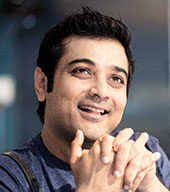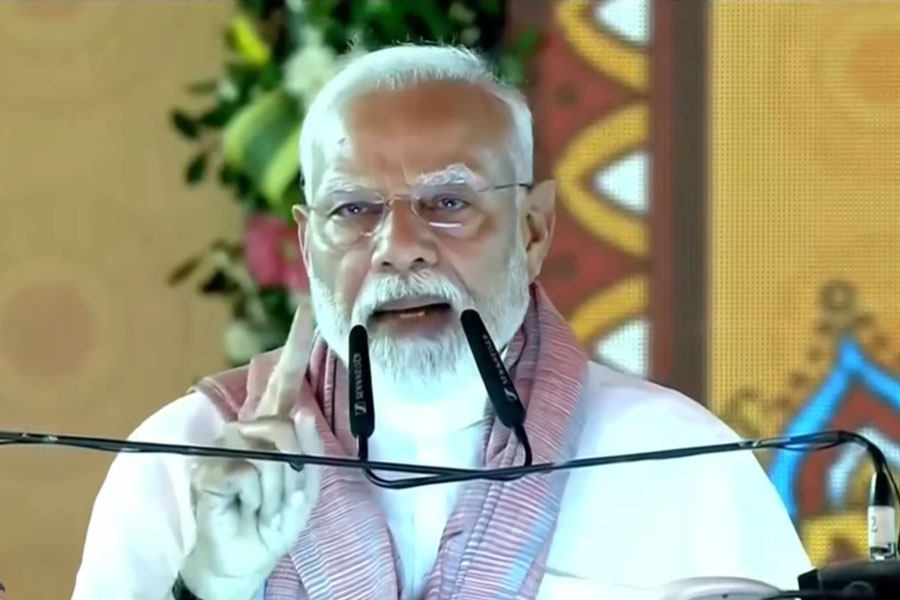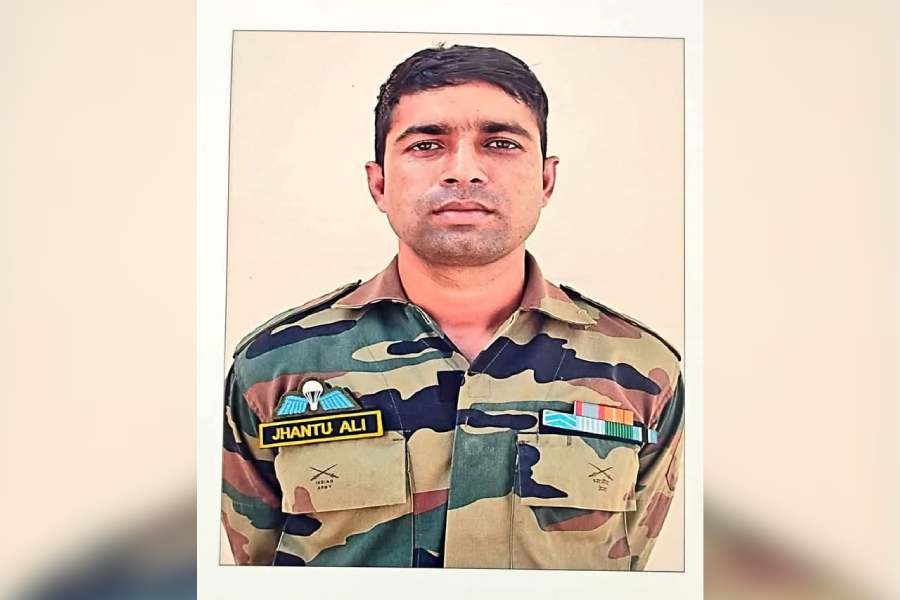 |
| Prosenjit is set to act in Ashwatthama |
Theatre is turning fashionable. Tollywood superstar Prosenjit has agreed to act in Ashwatthama, directed by Kaushik Sen. The play, written by Manoj Mitra, will open in March 2012.
“I want to grow as an actor. I want to learn. I need to practise,” says Prosenjit of the new role. His wife, the glamorous actress Arpita, is not left behind. In the dramatised version of Tagore’s Natir Puja, produced by Swapnasandhani and directed by Sen again, Arpita plays the dancer who undergoes a change of heart to turn into a Buddha disciple.
Mitra’s Ashwatthama is the story of the revered martial arts trainer Dronacharya’s son, who fought for the Kauravas in Mahabharat, but Mitra gives it his own interpretive slant. He wrote the final version of the play in 1971-1973 when the Naxalite movement was on. Ashwatthama begins 18 days after the Kurukshetra battle. Ashwatthama is battle-worn and full of misgivings about war and violence, but allows himself to be used for a heinous act — the killing of the Pandavas’ sons. To Mitra, he represents gullible youth exploited by political powers.
“I chose this Ashwatthama because I felt this play about terrorism and mindless violence has a deep relevance to the present and I chose Bumbada because I had heard he wanted to do theatre and this role would justify his talent,” says Kaushik Sen. “Sure I am using the star value but as long as I am sure of what I want to do I can’t go wrong,” says Sen. For Natir Puja, he says that the impetus “came from the fight of Irom Sharmila Chanu of Manipur against the Armed Forces Special Powers Act (AFSPA). Her lone struggle is a lot like Nati’s protest against the Hindu rulers.”
The play, produced in the 1970s by Bibhas Chakraborty’s Theatre Workshop, had had a good run.
Prosenjit is not alone. If Roopa Ganguly still cherishes her stage debut in Swapnasandhani’s Suprovat, Rituparna Sengupta wouldn’t mind trying theatre if the play is something really “spectacular and sophisticated”. “If it is something really special I will devote to it as much time as is needed,” she told Metro.
“Serious” theatre is a good thing to put on an actor’s CV. Says Surajit Bandyopadhyay, who will feature with Prosenjit in Ashwatthama: “If I didn’t come for rehearsals I would be earning more from serials or films, but who can forget the thrill of being on stage with all those eyes gazing at you, the warmth of audience reaction.”
Many faces from film and television have been or are being seen on stage: Gargi Roychowdhury, Sudipta Chakraborty, Dulal Lahiri, Kushal Chakraborty, Kaushik Sen, Rajatava Dutta, Sabyasachi Chakrabarty, Debshankar Haldar, Chaiti Ghoshal, Rita Datta Chakraborty, Debleena Dutta — the list is very long.
 |
| A moment from the play 221B Baker Street |
But for some, it may not only be recognition of seriousness.
Theatre usually pays little. Members of theatre groups who get salary grants from the ministry of culture can get Rs 4,000 to Rs 6,000 each month, an amount likely to be hiked to Rs 10,000. But the number of such beneficiaries is small. Most others try to split time between theatre and work in serials, for serials pay. According to Biswanath Dey, an assistant director with a serial production unit, newcomers in serials can earn Rs 1,000-1,500 a day; middle-level actors can charge Rs 1,500-Rs 3,000 daily and popular actors earn between Rs 6,000 and Rs 7,000 per day. In films, a leading actor is said to sign contracts of a few lakh; those in lesser roles, too, can get Rs 8,000 to Rs 35,000 a day.
Payment in theatre is usually half or even less of these rates. But if a known face crosses over from film or television, the payment may be more generous; there are other facilities, like AC rooms and transport facilities. Plus, a stage performance keeps them afloat when film roles are not forthcoming.
Dey says it is a cycle. “The film industry today gives a lot of importance to previous stage experience, because such actors can deliver at the first take.” So a lot of young actors are eager to join theatre groups. “We can expect a cycle of actors training in theatre, moving to films and when they are not as busy, returning to theatre.”
In return, the Bengali stage, which is seeking glamour for commercial success, is getting it in steady supply. “For theatre practitioners doing serials is an economic boost and for serial actors doing theatre is an intellectual boost,” says Dipak Das, a successful stage actor doing the occasional serial and film.
Other changes are being noticed. More footfalls are being reported at the plays. Production budgets are bigger, huge sometimes. The production of Suman Mukhopadhyay’s Lear cost Rs 30,000 per day.
New faces from outside theatre have arrived backstage. The element of cinema is being used on stage.
Filmmaker Gautam Haldar, who directed Nasta Neer, came to the stage with his resources. He could rustle up Rs 68 lakh for the play, based on the Tagore story. He has developed what he calls the “cine-play”, a new form inspired by Uday Shankar’s Shankarscope, where cinematic images coalesce with onstage action and dialogue. “A good play always finds its audience but a good film often doesn’t make it beyond the third day,” says Haldar.
In one Nasta Neer sequence, with the Rabindrasangeet Bhalobeshe sokhi playing in the background, Amal (Subhrojit Dutta) and his sister-in-law Charu (Ritabhori Chakraborty) come together; behind them on the screen the moon rises. Enter dancers. Then above Amal, Charu and the lunar orb appears the text announcing an interval of 10 minutes. Haldar is planning a play based on the Tagore novel Char Adhyay, using cine-play.
Then there is the “pro”. Arindam Mukherjee, an IIT Kharagpur, IIM Joka alumnus and a senior manager in an IT firm, could without much theatre experience write and direct 221B Baker Street, a production costing Rs 10.5 lakh. He rues that the play failed commercially, but his second venture Topi, which will premiere on November 26, is a low-budget Rs 3.5-lakh project.
Like Haldar, Mukherjee doesn’t like to approach the culture ministry for funds. He instead approaches friends and corporate houses in the country and abroad. “We want to break away from the dependence on government funds and involve the corporate sector just as it is involved in cultural activity in other countries,” he said.
This is not really a revival of the old commercial theatre that lingered on till the 1990s in the Hatibagan area.
The commercial theatre of yore was already flourishing for nearly 60 years when Bengali talkies began in the 1930s. Among those actors who came to commercial theatre after success in films were Gurudas Banerjee, Prabha Devi, Ahindra Chaudhury, Ashit Baran, Chhabi Biswas, Bhanu Banerjee, Jahar Roy, Uttam Kumar, Sabitri Chattopadhyay, Manju Dey, Sandhya Roy and Aparna Sen (see box). But the older set of actors who did both film and group theatre, such as Utpal Dutt and Manoj Mitra, kept their screen profiles non-glamorous, though Soumitra Chatterjee was an exception. For group theatre plays, the cast was never advertised. The play and production value were more important.
Now “serious” theatre wants glamour; rendering the line between “serious” and “commercial” indistinct.
Some think the presence of film and television actors now will prompt theatre groups to seek “readymade” actors, thus ending the theatre tradition of training and discipline.
Amidst all this a play is doing well quietly: Debi Sarpamasta, the first Bengali repertory production, written by Manoj Mitra and directed by Debesh Chattopadhyay. Here all the 24 members of the Minerva Natya Sanskriti Charcha Kendra repertory, were taught to act, sing, dance, and play folk instruments. The play makes a strong statement against the urban, educated and privileged classes exploiting nature. With minimal sets, innovative costumes and hard work (actors undertook 10-13 hours of workshops with tribal and folk artistes) the production is ready to take on all kinds of auditoriums. Full houses from day one proved that whether “serious” or “commercial”, low-budget or high-budget, with glamour or without it, there are only two kinds of plays — plays people like, plays people don’t.
FILM fraternity ON STAGE
 |










